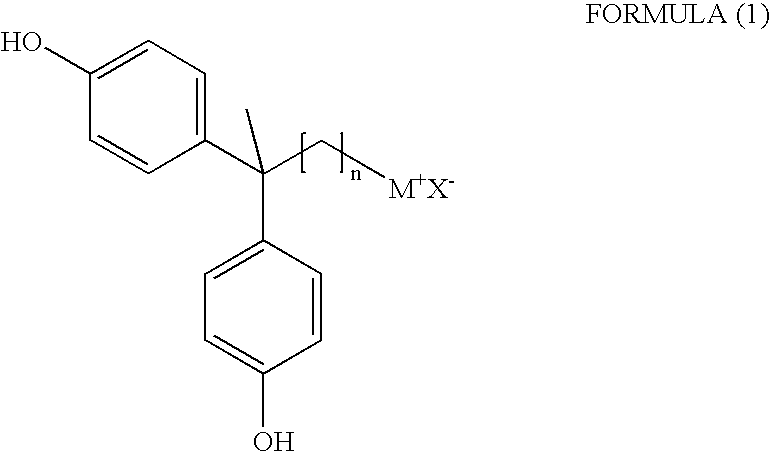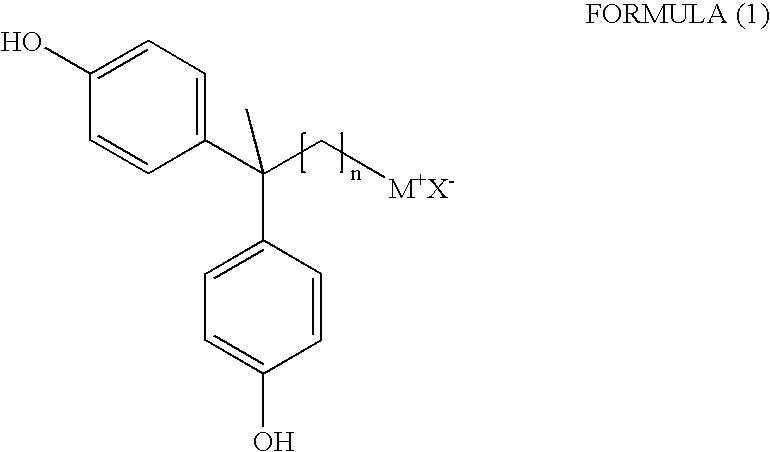2,2-Bis(4-hydroxyphenyl)-alkyl onium salt and process for the preparation thereof
a technology of alkyl onium salt and alkyl onium salt, which is applied in the field of 2,2bis (4hydroxyphenyl)alkyl onium salt and process for the preparation thereof, can solve the problems of impact strength, mechanical properties, intercalation of nanocomposites,
- Summary
- Abstract
- Description
- Claims
- Application Information
AI Technical Summary
Benefits of technology
Problems solved by technology
Method used
Image
Examples
example 2
[0058]Clean dry sodium (9.5 g, 0.413 mol) was placed in a three neck round bottomed flask fitted with double surface condenser, dropping funnel and septum adapter. Dry methanol (200 mL) was added on sodium slowly under cooling. Methyl acetoacetate (48.3 g, 0.416 mol) was added under stirring and heated to gentle heating. KI (5.6 g, 0.033 mol) was added. Then 10-bromodecan-1-ol (79 g, 0.33 mol) was taken in dropping funnel and added slowly into the contents of the round bottomed flask over a period of 60 min. Continued reflux for 12 hours and monitored the reaction by TLC. The reaction was stopped when all the bromodecanol was consumed. The crude reaction mixture was concentrated by evaporating methanol, diluted with ethyl acetate, washed with water several times until the washings were neutral to litmus. Pure methyl-(3-hydroxydecyldecyl)acetoacetate (58.3 g) was separated from crude by flash chromatography in 65% yield.
example 3
[0059]Hydroxyketoester (54.4 g, 0.20 mol) was dissolved in dimethyl sulfoxide (150 mL) in a round bottomed flask and NaCl (15 g, 0.25 mol) was added to it along with distilled water (18 g, 1.0 mol). The above mixture was heated at 150° C. for 18 hours. The reaction was continued until all the starting material was consumed, which was monitored by TLC. Cooling it to room temperature stopped the reaction. Then it was poured into water and extracted with diethyl ether. The combined ether layer was washed with water, brine and then dried over sodium sulfate. Then the ether was evaporated to get 13-hydroxytridecan-2-one (32.1 g) as a white solid, which was then purified by recrystallization in hot petroleum ether. Yield: 75%.
example 4
[0060]13-hydroxytridecan-2-one (21.4 g, 0.10 mol) was mixed with phenol (56.4 g, 0.60 mol) and mercaptopropionic acid (0.106 g, 0.010 mol) was added to it. The anhydrous HCl gas was passed to the reaction mixture through a bubbler. The reaction was continued under stirring for 12 hours at 45° C. Then the reaction mixture was dissolved in ethyl acetate and was washed with water, NaHCO3 and then brine. The organic layer was dried over Na2SO4. The excess phenol in the reaction mixture was distilled out under vacuum at 60° C. The 2,2-bis(4-hydroxyphenyl)tridecanol (25.0 g) was isolated by column chromatography. Yield: 65%.
PUM
| Property | Measurement | Unit |
|---|---|---|
| Temperature | aaaaa | aaaaa |
| Temperature | aaaaa | aaaaa |
| Temperature | aaaaa | aaaaa |
Abstract
Description
Claims
Application Information
 Login to View More
Login to View More - R&D
- Intellectual Property
- Life Sciences
- Materials
- Tech Scout
- Unparalleled Data Quality
- Higher Quality Content
- 60% Fewer Hallucinations
Browse by: Latest US Patents, China's latest patents, Technical Efficacy Thesaurus, Application Domain, Technology Topic, Popular Technical Reports.
© 2025 PatSnap. All rights reserved.Legal|Privacy policy|Modern Slavery Act Transparency Statement|Sitemap|About US| Contact US: help@patsnap.com



